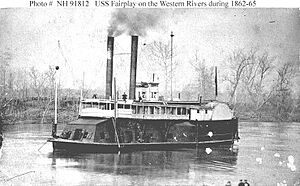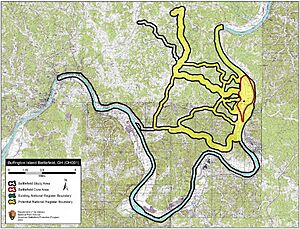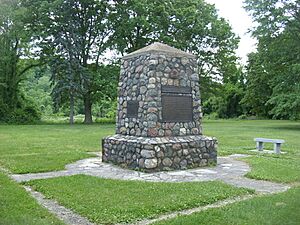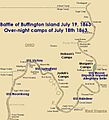Battle of Buffington Island facts for kids
Quick facts for kids Battle of Buffington Island |
|||||||
|---|---|---|---|---|---|---|---|
| Part of the American Civil War | |||||||
|
|||||||
| Belligerents | |||||||
| Commanders and leaders | |||||||
| Edward H. Hobson Henry M. Judah August Kautz LeRoy Fitch |
John H. Morgan Basil W. Duke Adam R. Johnson |
||||||
| Strength | |||||||
| 3,000: Cavalry Brigade, 3rd Division, XXIII Corps (Judah) 5th Indiana Cavalry 14th Illinois Cavalry 11th Kentucky Cavalry 8th Michigan Cavalry 9th Michigan Cavalry Battery "L" 1st Regiment Michigan Light Artillery Henshaw's Battery Illinois Light Artillery 14th Illinois Cavalry Battery 3rd Brigade, 1st Division, 23rd Army Corps (Kautz) 2nd Ohio Cavalry 7th Ohio Cavalry US Navy USS Moose Allegheny Belle Imperial |
1,930: First Brigade (Duke) 2nd Kentucky Cavalry 5th Kentucky Cavalry 6th Kentucky Cavalry 9th Kentucky Cavalry 9th Tennessee Cavalry Second Brigade (Johnson) 7th Kentucky Cavalry 8th Kentucky Cavalry 10th Kentucky Cavalry 11th Kentucky Cavalry 14th Kentucky Cavalry Kentucky Battery (four guns) |
||||||
| Casualties and losses | |||||||
| 25 killed 30 wounded |
52 killed 100 wounded 750 captured |
||||||
The Battle of Buffington Island was an important fight during the American Civil War. It happened on July 19, 1863, in Ohio and West Virginia. This battle was part of a larger event called Morgan's Raid. It was the biggest battle in Ohio during the war.
The battle helped the Union army capture a famous Confederate cavalry leader, Brigadier General John H. Morgan. Morgan and his men were trying to cross the Ohio River to escape Union soldiers. They wanted to use a shallow part of the river near Buffington Island.
Morgan's plan was delayed overnight. The next day, Union cavalry surrounded his forces. The battle ended with a big defeat for the Confederates. More than half of Morgan's 1,700 soldiers were captured. General Morgan and about 700 men managed to get away. But his daring raid ended a week later when he surrendered after the Battle of Salineville. Morgan's Raid didn't change the war much. However, it caused a lot of fear among people in southern and eastern Ohio and nearby Indiana.
Contents
Why the Battle Happened
General John H. Morgan led 2,460 Confederate cavalrymen. They also had some horse artillery (cannons). They started their journey from Sparta, Tennessee, on June 11, 1863. Morgan hoped to distract the Union's Army of the Ohio. He wanted to draw them away from Confederate forces in Tennessee.
Later, another Union army began its Tullahoma Campaign. Morgan then decided to move north. His group marched into Kentucky. They fought several small battles there. Then, they took two steamships to cross the Ohio River into Indiana. This was against their orders. In Indiana, at the Battle of Corydon, Morgan defeated the local militia (citizen soldiers).
With a clear path, Morgan headed east on July 13. He rode past Cincinnati and across southern Ohio. Along the way, his men stole horses and supplies.
The Union army quickly responded. Major General Ambrose Burnside was in charge of the Department of the Ohio. He ordered all available troops to chase Morgan. He also sent several Union Navy gunboats up the Ohio River. These boats were meant to stop Confederates from reaching Kentucky or West Virginia.
Brigadier General Edward H. Hobson led several groups of Union cavalry. They chased Morgan's raiders. By this time, Morgan's force had shrunk to about 1,930 men. Ohio Governor David Tod called out the local militia. Volunteers formed groups to protect towns and river crossings.
On July 18, Morgan brought his forces back together. He led them towards Middleport, Ohio. This was a quiet river town near the Eight Mile Island Ford. Morgan planned to cross into West Virginia there. But his men faced gunfire and couldn't reach the river or Middleport. So, he headed to the next ford upstream. This was at Buffington Island, about 20 miles away.
Morgan reached Buffington Island and the small town of Portland, Ohio, that evening. He found that several hundred local militia blocked the ford. They were hiding behind quickly built earthworks (dirt walls). A thick fog and darkness covered the area. Morgan decided to camp for the night. He wanted his tired men and horses to rest. He worried that even if he pushed past the militia, he might lose more men in the dark. This delay turned out to be a big mistake.
The U.S. Navy's Mississippi Squadron played a part in the Battle of Buffington Island. Morgan had brought cannons with his soldiers. The Union realized early on that they needed to block the river. This was important as Morgan's group moved towards Cincinnati.
Lieutenant Commander LeRoy Fitch led the Union Navy's fleet. His fleet included several gunboats. Some of these were "tinclads" and "ironclads." These were boats with metal armor. A few boats stayed behind to guard against Morgan's forces turning back. The boats in front were given patrol areas along the West Virginia side of the river.
Fitch's main ship was the ironclad USS Moose. The Moose and Fitch's fast privateer boat, Imperial, were tied up near the island the night before the battle. It is said that Fitch had the Mooses boilers ready. He started firing its large cannons at the island when the first shots were heard. The Allegheny Belle was a bit further down the river. It also joined the fight after hearing the Mooses cannons.
After the main battle, the USS Moose continued upstream. It fired on a Confederate artillery group trying to cross the river. Fitch sent the Imperial to get Confederate cannons left behind. All along the river, there was gunfire from boats and cannons. Rifle fire was also heard as Morgan's scouts looked for other places to cross.
A supply base in Parkersburg, West Virginia, sent an armed boat. This boat had soldiers on it. It patrolled below Blennerhassett Island. This was after hearing the battle's gunfire about twenty miles away. This river harbor and large army camp blocked Morgan's attempts to cross the river further upstream. This forced his retreat north, away from the Ohio River. Local support boats were busy carrying ammunition, rations, and prisoners. Belpre, Ohio, had a dock and supply depot for the Union army.
The Battle Unfolds
On the foggy morning of July 19, two Union brigades arrived. They were led by August Kautz and Henry M. Judah. They finally caught up with Morgan. They attacked his position on a wide, flat area north of Portland. They almost surrounded the Confederates. Another Union group, led by James M. Shackelford, also arrived.
In the early, fierce fighting, Major Daniel McCook was badly wounded. He was a 65-year-old leader from the famous Fighting McCooks family. Nearly 3,000 Union soldiers were fighting Morgan's tired and outnumbered men.
Also, two Union gunboats, the U.S.S. Moose and the U.S.S. Allegheny Belle, entered the narrow channel. This channel separated Buffington Island from the land. They opened fire on Morgan's men. Shell fragments sprayed everywhere. Soon, a third gunboat joined them.
Morgan's path to the Buffington Island ford was completely blocked. He left a small group to guard the rear. He tried to fight his way north along the flat land. He hoped to find another place to cross the river. But it was useless. Union groups came together and split Morgan's force. Fifty-two Confederates were killed. Over one hundred were badly wounded in the chaotic fighting.
Morgan and about 700 men escaped being surrounded. They followed a narrow path through the woods. However, his brother-in-law and second-in-command, Colonel Basil W. Duke, was captured. Over 750 of Morgan's cavalrymen were also captured. This included his younger brother, John Morgan. Duke formally surrendered to Colonel Isaac Garrard of the 7th Ohio Cavalry.
Morgan's remaining troops soon headed upstream. They went to an unguarded ford near Belleville, West Virginia. Over 300 men successfully crossed the Ohio River there to avoid capture. These included Colonel Adam "Stovepipe" Johnson and the famous telegraph operator George Ellsworth. General Morgan was halfway across the ford. He saw with dismay that his remaining men were trapped on the Ohio side. The Union gunboats suddenly appeared. He turned his horse around in the middle of the river. He rejoined what was left of his group on the Ohio riverbank. Over the next few days, they couldn't find a safe place to cross the river. Morgan's remaining force was captured on July 26 in northern Ohio. This happened after the Battle of Salineville.
Many of those captured at Buffington Island were taken by steamboat to Cincinnati. They became prisoners of war. This included most of the wounded. Morgan and most of his officers were held in the Ohio Penitentiary in Columbus. Morgan, Thomas Hines, and a few others later escaped. They safely returned to Kentucky.
Protecting the Battlefield
|
Buffington Island
|
|
| Nearest city | Pomeroy, Ohio |
|---|---|
| Area | 4 acres (1.6 ha) |
| Built | 1863 |
| NRHP reference No. | 70000508 |
| Added to NRHP | November 10, 1970 |
The Buffington Island battlefield has not changed much over time. The biggest difference is a stone obelisk (a tall, thin monument) that marks the battle. In 1929, the Ohio History Connection took ownership of the land. In 1970, the battlefield was added to the National Register of Historic Places. This means it is recognized as an important historic site. The protected part of the battlefield is about 4 acres near the river. It was the first place in the county to get this special recognition.
However, there are still threats to the site. Gravel mining operations have been allowed nearby. The Buffington Island Battlefield Preservation Foundation is currently working to protect the battlefield.
Images for kids











